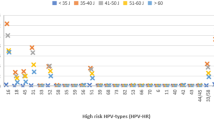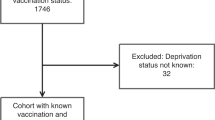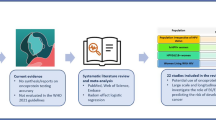Abstract
Human papillomavirus (HPV) testing has been suggested for primary screening of cervical cancer. Prediction of future high-grade cervical lesions is crucial for effectiveness and cost. We performed a case control study in a retrospective cohort of women with at least two cervical smears, all but the last one being negative, from the organized cervical screening programme in Florence, Italy. We searched for high-risk HPV in all previous, archival, smears from cases (new histologically confirmed cervical intraepithelial neoplasia (CIN) grade II or worse) and in one previous smear from each control (last smear cytologically normal, matched by age and interval (latency) from last smear). We applied polymerase chain reaction (PCR), and the b-globin gene was used as a DNA preservation marker. High-risk HPV was identified in 71/92 (77.17%) previous smears from 79 cases and 17/332 controls (5.12%). The odds ratio (OR) was 63.76 (95% CI 30.57–132.96). Among cases the proportion of HPV-positive smears declined slightly with increasing latency. Among cases, HPV was found in 81.24% (95% CI 69.93–88.96%) of smears with latency < 4 years and in 67.80% (95% CI 47.72–82.93%) of those taken at longer intervals, up to 6 years. These findings suggest that testing for high-risk HPV allows predicting 80% of CINII/III 3 years before the cytological diagnosis and two thirds 6 years before. They also suggest that testing women negative for high-risk HPV at longer interval and strictly following-up women who are HPV positive could be an effective strategy for cervical cancer screening. © 2000 Cancer Research Campaign http://www.bjcancer.com
Similar content being viewed by others
Article PDF
Change history
16 November 2011
This paper was modified 12 months after initial publication to switch to Creative Commons licence terms, as noted at publication
References
Van Ballegoijen M M, Akker van Marle ME, Van den Warmerdam PG, Meijer CJLM, Walboomers JMM and Habbema JDF (1997 Present evidence on the value of HPV testing for cervical cancer screening: a model-based exploration of the (cost-) effectiveness. B J Cancer 76: 651–657
Brookmeyer R, Liang KY and Linet M (1986 Matched case-control designs and overmatched analyses. Am J Epidemiol 124: 693–701
Burk RD, Kelly P, Feldman J, Bromberg J, Vermund SH, DeHovitz JA and Landesman SH (1996 Declining prevalence of cervicovaginal human papillomavirus infection with age is independent of other risk factors. Sex Transm Dis 23: 333–341
Clavel C, Masure M, Bory JP, Mangeonjean C, Lorenzato M, Gabriel R, Quereux C and Birembaut P (1999 Hybrid capture II-based human papillomavirus detection, a sensitive test to detect in routine high grade cervical lesions: a preliminary study on 1518 women. B J Cancer 80: 1306–1311
Confortini M, Biggeri A, Cariaggi MP, Carozzi FM, Minuti PA, Russo A and Palli D (1993 Intralaboratory reproducibility in cervical cytology. Results of the application of a 100-slide set. Acta Cytol 37: 49–54
Cuzick J (2000 Human papillomavirus testing for primary cervical cancer screening. JAMA 283: 108–109
Cuzick J, Szarewski A, Terry G, Ho L, Hanby A, Maddox P, Anderson M, Kocjan G, Steele ST and Guilleband J (1995 Human papillomavirus testing in primary cervical screening. Lancet 345: 1533–1536
Cuzick J, Beverley E, Ho L, Terry G, Sapper H, Mielzynska Lorincz A, Chan WK, Krausz T and Soutter P (1999 HPV testing in primary screening of older women. BJ Cancer 81: 554–558
Fujinaga Y, Shimada M, Okazawa K, Fukushima M, Kato I and Fujinaga K (1991 Simultaneous detection and typing of genital human papilloma virus DNA using the polymerase chain reaction. J General Virol 72: 1039–1044
Gustafsson L and Adami HO (1989 Natural history of cervical neoplasia: consistent results obtained by an identification technique. Br J Cancer 60: 132–141
Gustaffson L and Adami HO (1992 Optimisation of cervical cancer screening. Cancer Causes and Control 3: 125–136
Ho GYF, Burk RD, Klein S, Kadish AS, Chang CJ, Palan P, Basu J, Tachezy R, Lewis R and Romney S (1995 Persistent genital human papillomavirus infection as a risk factor for persistent cervical dysplasia. J Natl Cancer Inst 87: 1365–1371
International Agency for Research on Cancer (1995 Human Papillomaviruses. IARC Monographs on the evaluation of carcinogenic risks to humans 64: 133–134, Lyon
Kjellberg L, Wilklund F, Sjöberg I, Wadell G, Ångström T, Dillner J and Mählck CG (1998 A population-based study of human papillomavirus deoxyribonucleic acid testing for predicting cervical intraepithelial neoplasia. Am J Obstet Gynecol 179: 1497–1502
Liaw KL, Glass AG, Manos MM, Greer CE, Scott DR, Sherman M, Burk RD, Kurman RJ, Wacholder S, Rush BB, Cadell DM, Lawler P, Tabor D and Schiffman M (1999 Detection of human papillomavirus in cytologically normal women and subsequent cervical squamous intraepithelial lesions. J Natl Cancer Inst 91: 954–960
Meijer CJLM, Brule AJC, van den Snijders PJF, Helmerhorst T, Kenemans P and Walboomers JMM (1992 Detection of human papillomavirus in cervical scrapes by the polymerase chain reaction in relation to cytology: possible implications for cervical cancer screening. Munoz N, Bosch FX, Shah KV, Meheus A (eds), The epidemiology of cervical cancer and human papillomavirus. IARC Scientific Publications No 119, Lyon,IARC
Melkert PWJ, Hopman E, van den Brule AJC, Risse EKI, van Diest PJ, Bleker OP, Hlemerhorst T, Schipper EI, Meijer CJLM and Walboomers JMM (1993 Prevalence of HPV in cytomorphologically normal cervical smears, as determined by polymerase chain reaction, is age-dependent. Int J Cancer 53: 919–923
Morrison EAB, Ho GYF, Vermund SH, Goldberg GL, Kadish AS, Kelley KF and Burk RD (1991 Human papillomavirus infection and other risk factors for cervical neoplasia: a case-control study. Int J Cancer 49: 6–13
Nobbenhuis M, Walboomers JMM, Helmerhorst TJM, Rozendaal L, Remmink AJ, Risse EKJ, van der Linden HC, Voorhorst FJ, Kenemans P and Meijer CJHLM (1999 Relation of human papillomavirus to cervical lesions and consequences for cervical cancer screening: a prospective study. Lancet 354: 20–25
Van Oortmarssen GJ and Habbema JDF (1991 Epidemiological evidence for age-dependent regression of pre-invasive cervical cancer. BJ Cancer 64: 559–565
Palli D, Carli S, Cecchini S, Venturini A, Piazzesi G and Buiatti E (1990 A centralised cytologic screening programme for cervical cancer in Florence. J Epidemiol Community Health 44: 47–51
Palli D, Confortini M, Biggeri A, Russo A, Cariaggi MP and Carozzi MF (1993 A quality control system involving peer review of abnormal cervical smears. Cytopathology 4: 17–25
Reid R, Greenberg MD, Lorincz A, Jenson AB, Laverty CR and Husain M (1991 Should cervical cytology testing be augmented by cervicography or human papillomavirus deoxyribonucleic acid detection?. Am J Obstet Gynecol 164: 1461–1471
Remmink AJ, Walboomers JMM, Helmerhorst TJM, Voorhorst FJ, Rozendaal L, Risse EKJ, Meijer CJLM and Kenemans P (1995 The presence of persistent high-risk HPV genotypes in dysplastic cervical lesions is associated with progressive disease: natural history up to 36 months. Int J Cancer 61: 306–311
Richart RM (1995 Screening. The next century. Cancer 76(10 suppl): 1919–1927
de Roda Husman AM, Snijders PJ, Stel HV, Brule AJC, van den Meijer CJLM and Walboomers JMM (1995 Processing long-stored archival cervical smears for human papillomavirus detection by the polymerase chain reaction. Br J Cancer 72: 412–417
Ronco G and Biggeri A (1999 Estimating sensitivity and specificity when repeated tests are performed on the same subject. J Epidemiol Biostatistics 4: 329–336
Rozendaal L, Walboomers JMM, Linden JC, van der Voorhorst FJ, Kenemans P, Helmerhorst THJM, Ballegooijen M and Van Meijer CJLM (1996 PCR-based high-risk HPV test in cervical cancer screening gives objective risk assessment of women with cytomorphologically normal cervical smears. Int J Cancer 68: 766–769
Schiffman MH (1992 Recent progress in defining the epidemiology of Human Papillomavirus infection and cervical neoplasia. J Natl Cancer Inst 84: 394–398
Schiffman MH, Herrero R, Hildesheim A, Sherman ME, Bratti M, Wacholder S, Alfaro M, Hutchinson M, Morales J, Greenberg MD and Lorincz AT (2000 HPV DNA testing in cervical cancer screening: results from women in a high-risk province of Costa Rica. JAMA 283: 87–93
Solomon D D (1993 Screening for cervical cancer: prospects for the future. J Natl Cancer Inst 85: 1019
Svare EI, Kjaer SK, Smits HL, Poll P, Tjong-A-Hung SP and ter Schegget J (1998 Risk factors for HPV detection in archival smears. A population based study from Greenland and Denmark. Europ J Cancer 34: 1230–1234
Walboomers JMM, Roda Husman AM, de Snijders PJF, Stel HV, Risse EK, Helmerhorst TJ, Voorhorst FJ and Meijer CJLM (1995 Human papillomavirus in false negative archival cervical smears: implications for screening for cervical cancer. J Clin Pathol 48: 728–732
Wallin KL, Wilklund F, Ångström T, Bergman F, Stendhal U, Wadell G, Hallmans G and Dillner J (1999 Type specific persistence of human papillomavirus DNA before the development of invasive cervical cancer. N Engl J Med 341: 1633–1638
Wright TC Jr, Denny L, Kuhn L, Pollack A and Lorincz A (2000 HPV DNA testing of self-collected vaginal samples compare with cytologic screening to detect cervical cancer. JAMA 283: 81–86
Zeger SL and Liang KY (1986 Longitudinal analysis for discrete and continuous outcomes. Biometrics 42: 121–130
Author information
Authors and Affiliations
Rights and permissions
From twelve months after its original publication, this work is licensed under the Creative Commons Attribution-NonCommercial-Share Alike 3.0 Unported License. To view a copy of this license, visit http://creativecommons.org/licenses/by-nc-sa/3.0/
About this article
Cite this article
Carozzi, F., Ronco, G., Confortini, M. et al. Prediction of high-grade cervical intraepithelial neoplasia in cytologically normal women by human papillomavirus testing. Br J Cancer 83, 1462–1467 (2000). https://doi.org/10.1054/bjoc.2000.1491
Received:
Revised:
Accepted:
Published:
Issue date:
DOI: https://doi.org/10.1054/bjoc.2000.1491
This article is cited by
-
Cervical nitric oxide metabolite levels and clinical variables as predictive factors of high-grade cervical intraepithelial neoplasia
Archives of Gynecology and Obstetrics (2013)
-
Prediction of high-grade squamous intraepithelial lesions using the modified Reid index
International Journal of Clinical Oncology (2010)
-
Human papillomavirus infection in women who develop high-grade cervical intraepithelial neoplasia or cervical cancer: a case–control study in the UK
British Journal of Cancer (2005)



